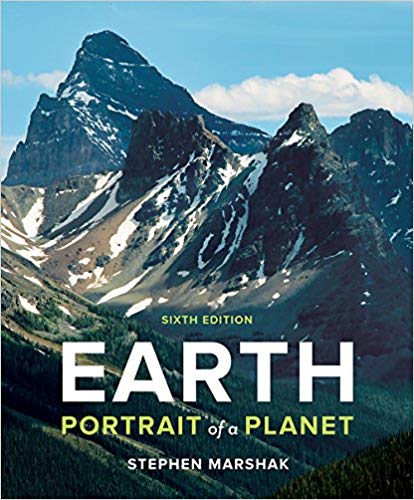This is completed downloadable of Solution Manual for Earth: Portrait of a Planet (Sixth Edition) Sixth Edition

Product Details:
- ISBN-10 : 0393640132
- ISBN-13 : 978-0393640137
- Author: Stephen Marshak
Marshak gives students the tools they need for an enriching hands-on geology experience, in and out of class. The Sixth Edition includes an expanded suite of interactive simulations, Narrative Art videos, Real-World videos, and animations built on the vibrant art from the text. New Smartwork5 online activities provide visual and interactive questions with answer-specific feedback. And the Geotours Google Earth™ exercises get students applying what they’ve learned to real-life site explorations. These easy-to-use tools combine with Marshak’s signature narrative approach to the text and art program to give students the most effective means for visualizing, interacting with, and mastering geology concepts.
Table of contents
- P.1 In Search of Ideas
- P.2 Why Study Geology?
- P.3 Themes of This Book
- Prelude: Practice What You Know
- Part I: Our Island in Space
- Chapter 1: Cosmology and the Birth of the Earth
- 1.1 Introduction
- 1.2 An Image of Our Universe
- 1.3 Forming the Universe
- 1.4 We Are All Made of Stardust
- Chapter 1: Practice What You Know
- Chapter 2: Journey to the Center of the Earth
- 2.1 Introduction
- 2.2 Welcome to the Neighborhood
- 2.3 Basic Characteristics of the Earth
- 2.4 How Do We Know That the Earth Has Layers?
- 2.5 What Are the Layers Made of?
- 2.6 The Lithosphere and the Asthenosphere
- Chapter 2: Practice What You Know
- Chapter 3: Drifting Continents and Spreading Seas
- 3.1 Introduction
- 3.2 Wegener’s Evidence for Continental Drift
- 3.3 The Discovery of Seafloor Spreading
- 3.4 Paleomagnetism: Proving Continental Drift and Seafloor Spreading
- Chapter 3: Practice What You Know
- Chapter 4: The Way the Earth Works: Plate Tectonics
- 4.1 Introduction
- 4.2 What Do We Mean by Plate Tectonics?
- 4.3 Divergent Boundaries and Seafloor Spreading
- 4.4 Convergent Boundaries and Subduction
- 4.5 Transform Boundaries
- 4.6 Special Locations in the Plate Mosaic
- 4.7 How Do Plate Boundaries Form, and How Do They Die?
- 4.8 Moving Plates
- Chapter 4: Practice What You Know
- Part II: Earth Materials
- Chapter 5: Patterns in Nature: Minerals
- 5.1 Introduction
- 5.2 What Is a Mineral?
- 5.3 Beauty in Patterns: Crystals and Their Structure
- 5.4 How Can You Tell One Mineral from Another?
- 5.5 Organizing Knowledge: Mineral Classification
- 5.6 Something Precious: Gems!
- Chapter 5: Practice What You Know
- Interlude A: Introducing Rocks
- A.1 Introduction
- A.2 What Is Rock?
- A.3 The Basis of Rock Classification
- A.4 Studying Rock
- Interlude A: Practice What You Know
- Chapter 6: Up from the Inferno: Magma and Igneous Rocks
- 6.1 Introduction
- 6.2 Why Do Melts Form?
- 6.3 What’s in Molten Rock?
- 6.4 Movement and Solidification of Molten Rock
- 6.5 Comparing Extrusive and Intrusive Environments
- 6.6 How Do You Describe an Igneous Rock?
- 6.7 Plate Tectonic Context of Igneous Activity
- Chapter 6: Practice What You Know
- Interlude B: A Surface Veneer: Sediments and Soils
- B.1 Introduction
- B.2 Weathering: Forming Sediment
- B.3 Soil
- Interlude B: Practice What You Know
- Chapter 7: Pages of the Earth’s Past: Sedimentary Rocks
- 7.1 Introduction
- 7.2 Classes of Sedimentary Rocks
- 7.3 Sedimentary Structures
- 7.4 How Do We Recognize Depositional Environments?
- 7.5 Sedimentary Basins
- Chapter 7: Practice What You Know
- Chapter 8: Metamorphism: A Process of Change
- 8.1 Introduction
- 8.2 Consequences and Causes of Metamorphism
- 8.3 Types of Metamorphic Rocks
- 8.4 Defining Metamorphic Intensity
- 8.5 Where Does Metamorphism Occur?
- Chapter 8: Practice What You Know
- Interlude C: The Rock Cycle in the Earth System
- C.1 Introduction
- C.2 Rock Cycle Paths
- C.3 A Case Study of the Rock Cycle
- C.4 Cycles of the Earth System
- Interlude C: Practice What You Know
- Part III: Tectonic Activity of a Dynamic Planet
- Chapter 9: The Wrath of Vulcan: Volcanic Eruptions
- 9.1 Introduction
- 9.2 The Products of Volcanic Eruptions
- 9.3 Structure and Eruptive Style
- 9.4 Geologic Settings of Volcanism
- 9.5 Beware: Volcanoes Are Hazards!
- 9.6 Protection from Vulcan’s Wrath
- 9.7 Effect of Volcanoes on Climate and Civilization
- 9.8 Volcanoes on Other Planets
- Chapter 9: Practice What You Know
- Chapter 10: A Violent Pulse: Earthquakes
- 10.1 Introduction
- 10.2 What Causes Earthquakes?
- 10.3 Seismic Waves and Their Measurement
- 10.4 Defining the “Size” of Earthquakes
- 10.5 Where and Why Do Earthquakes Occur?
- 10.6 How Do Earthquakes Cause Damage?
- 10.7 Can We Predict the “Big One”?
- 10.8 Earthquake Engineering and Zoning
- Chapter 10: Practice What You Know
- Interlude D: The Earth’s Interior, Revisited: Seismic Layering, Gravity, and the Magnetic Field
- D.1 Introduction
- D.2 The Basis for Seismic Study of the Earth’s Interior
- D.3 Seismic Study of the Earth’s Interior
- D.4 The Earth’s Gravity
- D.5 The Earth’s Magnetic Field, Revisited
- Interlude D: Practice What You Know
- Chapter 11: Crags, Cracks, and Crumples: Geologic Structures and Mountain Building
- 11.1 Introduction
- 11.2 Rock Deformation in the Earth’s Crust
- 11.3 Brittle Structures
- 11.4 Folds and Foliation
- 11.5 Causes of Mountain Building
- 11.6 Mountain Topography
- 11.7 Basins and Domes in Cratons
- 11.8 Life Story of a Mountain Range: A Case Study
- Chapter 11: Practice What You Know
- Part IV: History before History
- Interlude E: Memories of Past Life: Fossils and Evolution
- E.1 The Discovery of Fossils
- E.2 Fossilization
- E.3 Characterizing Life of the Past
- E.4 Evolution and Extinction
- Interlude E: Practice What You Know
- Chapter 12 Deep Time: How Old Is Old?
- 12.1 Introduction
- 12.2 The Concept of Geologic Time
- 12.3 Relative Age
- 12.4 Unconformities: Gaps in the Record
- 12.5 Stratigraphic Formations and Their Correlation
- 12.6 The Geologic Column
- 12.7 How Do We Determine Numerical Ages?
- 12.8 Numerical Ages and Geologic Time
- Chapter 12: Practice What You Know
- Chapter 13: A Biography of the Earth
- 13.1 Introduction
- 13.2 Methods for Studying the Past
- 13.3 The Hadean Eonand Before
- 13.4 The Archean Eon: Birth of Continents and Life
- 13.5 The Proterozoic Eon: The Earth in Transition
- 13.6 The Paleozoic Era: Continents Reassemble and Life Gets Complex
- 13.7 The Mesozoic Era: When Dinosaurs Ruled
- 13.8 The Cenozoic Era: The Modern World Comes to Be
- Chapter 13: Practice What You Know
- Part V: Earth Resources
- Chapter 14: Squeezing Power from a Stone: Energy Resources
- 14.1 Introduction
- 14.2 Sources of Energy in the Earth System
- 14.3 Introducing Hydrocarbon Resources
- 14.4 Conventional Hydrocarbon Systems
- 14.5 Unconventional Hydrocarbon Reserves
- 14.6 Coal: Energy from Swamps of the Past
- 14.7 Nuclear Power
- 14.8 Other Energy Sources
- 14.9 Energy Choices, Energy Problems
- Chapter 14: Practice What You Know
- Chapter 15: Riches in Rock: Mineral Resources
- 15.1 Introduction
- 15.2 Metals and Their Discovery
- 15.3 Ores, Ore Minerals, and Ore Deposits
- 15.4 Ore-Mineral Exploration and Production
- 15.5 Nonmetallic Mineral Resources
- 15.6 Global Mineral Needs
- Chapter 15: Practice What You Know
- Part VI: Processes and Problems at the Earth’s Surface
- Interlude F: Ever-Changing Landscapes and the Hydrologic Cycle
- F.1 Introduction
- F.2 Shaping the Earth’s Surface
- F.3 Factors Controlling Landscape Development
- F.4 The Hydrologic Cycle
- F.5 Landscapes of Other Planets
- Interlude F: Practice What You Know
- Chapter 16: Unsafe Ground: Landslides and Other Mass Wasting
- 16.1 Introduction
- 16.2 Types of Mass Wasting
- 16.3 Why Does Mass Wasting Occur?
- 16.4 Where Does Mass Wasting Occur?
- 16.5 How Can We Protect against Mass-Wasting Disasters?
- Chapter 16: Practice What You Know
- Chapter 17: Streams and Floods: The Geology of Running Water
- 17.1 Introduction
- 17.2 Draining the Land
- 17.3 Describing Flow in Streams
- 17.4 The Work of Running Water
- 17.5 How Do Streams Change along Their Length?
- 17.6 Streams and Their Deposits in the Landscape
- 17.7 The Evolution of Fluvial Landscapes
- 17.8 Raging Waters
- 17.9 Vanishing Rivers
- Chapter 17: Practice What You Know
- Chapter 18: Restless Realm: Oceans and Coasts
- 18.1 Introduction
- 18.2 Landscapes beneath the Sea
- 18.3 Ocean-Water Characteristics
- 18.4 Tides
- 18.5 Wave Action
- 18.6 Currents: Rivers in the Sea
- 18.7 Where Land Meets Sea: Coastal Landforms
- 18.8 Causes of Coastal Variation
- 18.9 Coastal Problems and Solutions
- Chapter 18: Practice What You Know
- Chapter 19: A Hidden Reserve: Groundwater
- 19.1 Introduction
- 19.2 Where Does Groundwater Reside?
- 19.3 Characteristics of the Water Table
- 19.4 Groundwater Flow
- 19.5 Tapping Groundwater Supplies
- 19.6 Hot Springs and Geysers
- 19.7 Groundwater Problems
- 19.8 Caves and Karst
- Chapter 19: Practice What You Know
- Chapter 20: An Envelope of Gas: The Earth’s Atmosphere and Climate
- 20.1 Introduction
- 20.2 The Formation of the Atmosphere
- 20.3 General Atmospheric Characteristics
- 20.4 Atmospheric Layers
- 20.5 Wind and Global Circulation in the Atmosphere
- 20.6 Weather and Its Causes
- 20.7 Storms: Nature’s Fury
- 20.8 Global Climate
- Chapter 20: Practice What You Know
- Chapter 21: Dry Regions: The Geology of Deserts
- 21.1 Introduction
- 21.2 The Nature and Location of Deserts
- 21.3 Producing Desert Landscapes
- 21.4 Deposition in Deserts
- 21.5 Desert Landforms and Life
- 21.6 Desert Problems
- Chapter 21: Practice What You Know
- Chapter 22: Amazing Ice: Glaciers and Ice Ages
- 22.1 Introduction
- 22.2 Ice and the Nature of Glaciers
- 22.3 Carving and Carrying by Ice
- 22.4 Deposition Associated with Glaciation
- 22.5 Consequences of Continental Glaciation
- 22.6 The Pleistocene Ice Age
- 22.7 The Causes of Ice Ages
- Chapter 22: Practice What You Know
- Chapter 23: Global Change in the Earth System
- 23.1 Introduction
- 23.2 Unidirectional Changes
- 23.3 Cyclic Changes
- 23.4 Global Climate Change
- 23.5 Human Impact on Land and Life
- 23.6 Recent Climate Change
- 23.7 The Future of the Earth
- Chapter 23: Practice What You Know
- Additional Charts: Metric Conversion Chart
- The Periodic Table of Elements
- Glossary
- Credits
- Index





